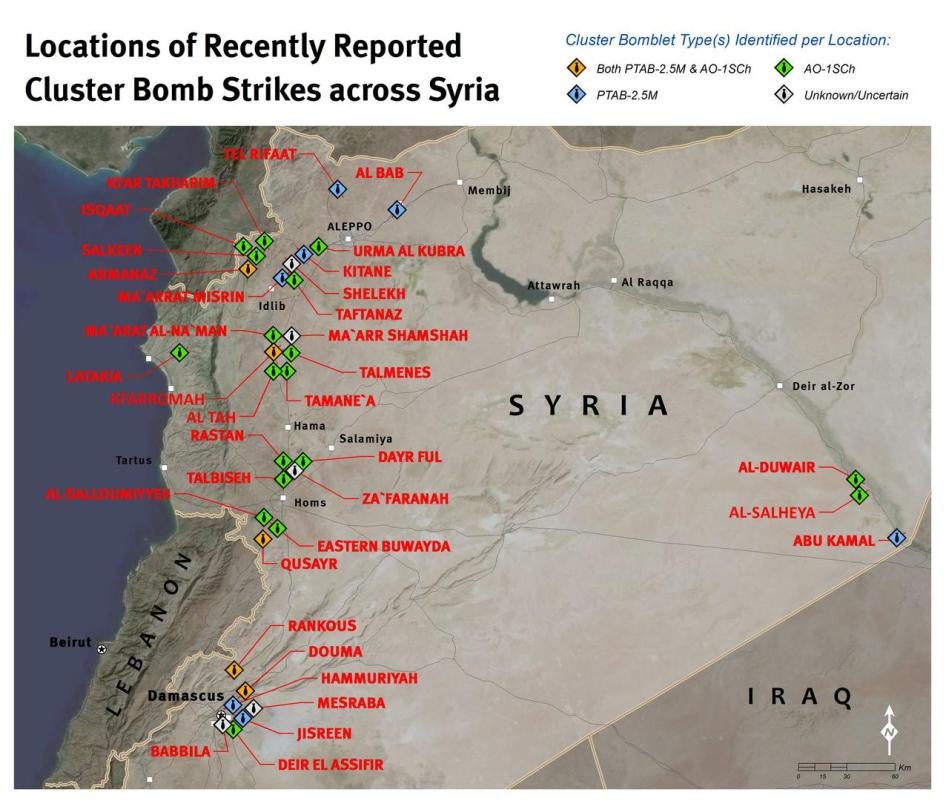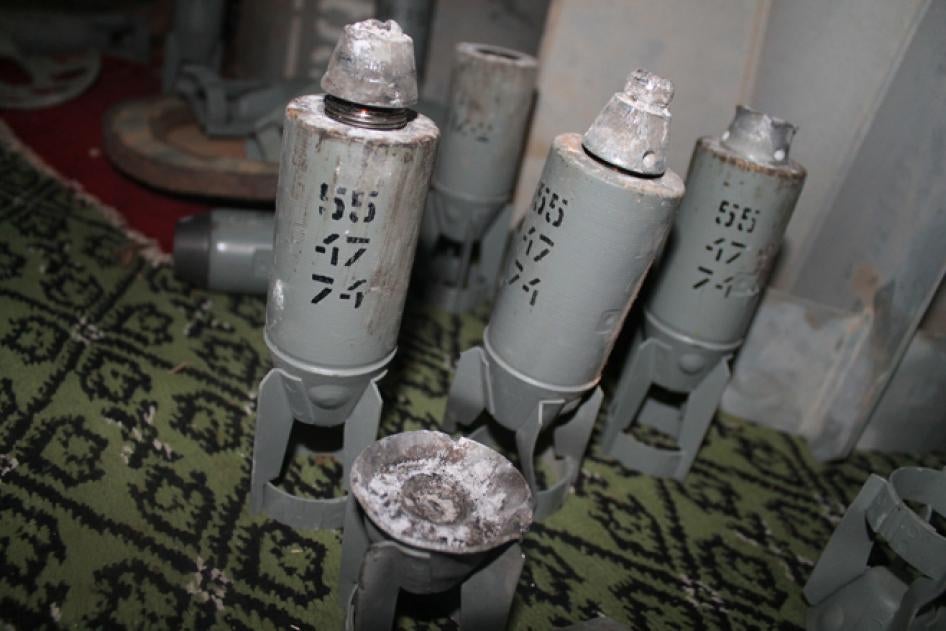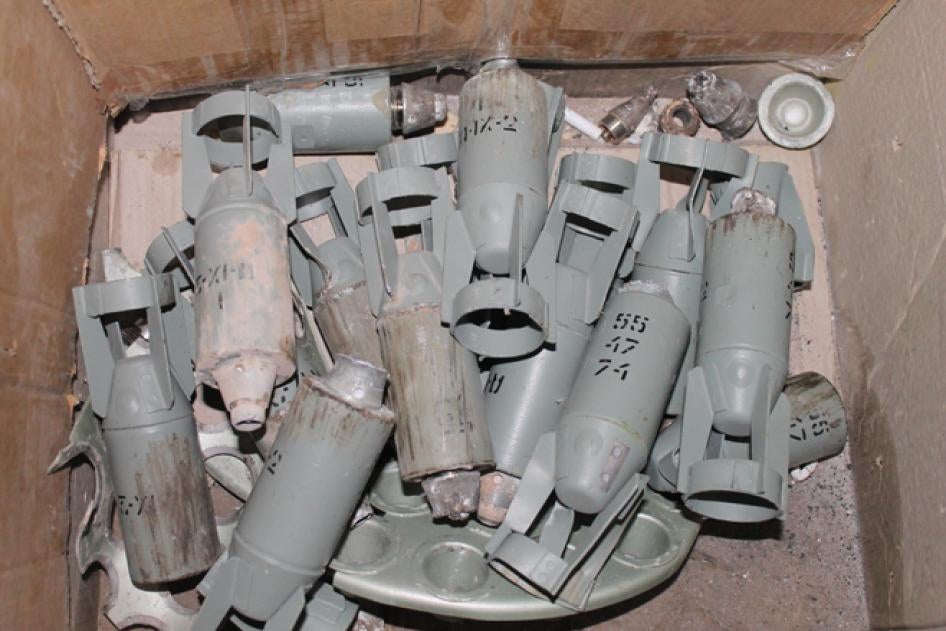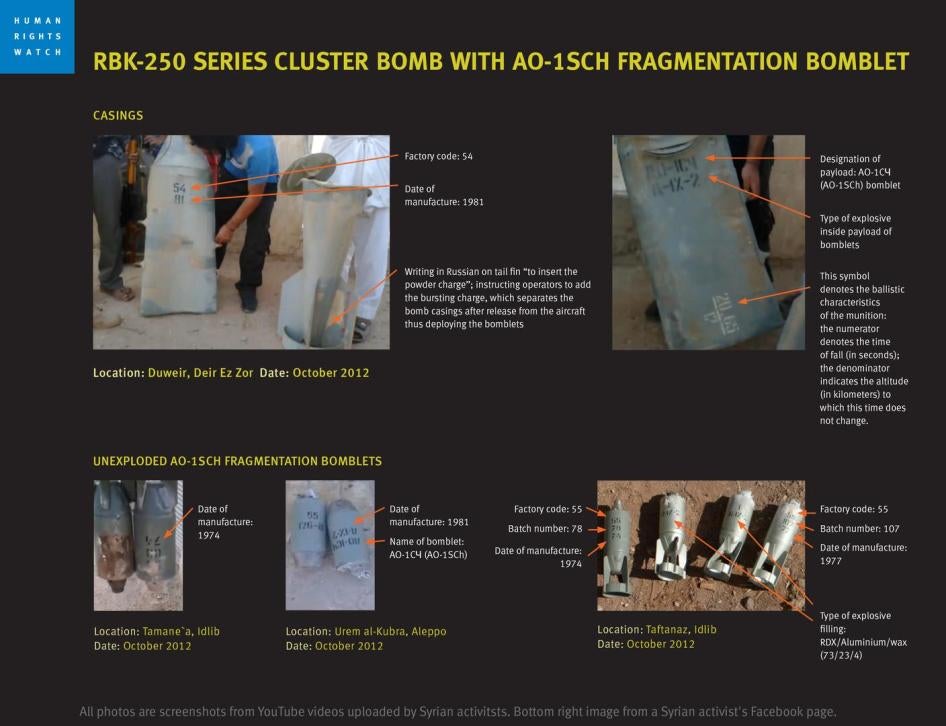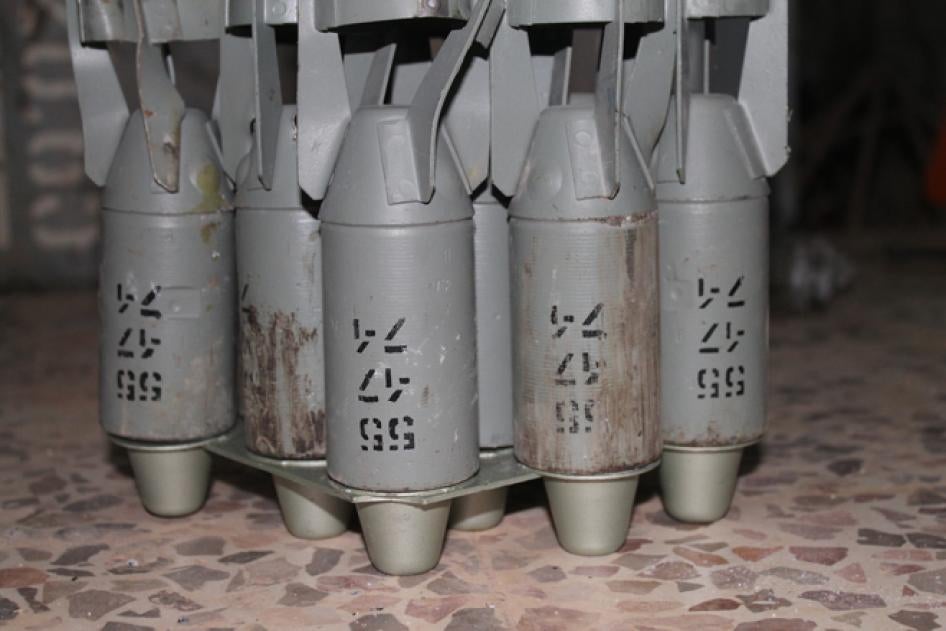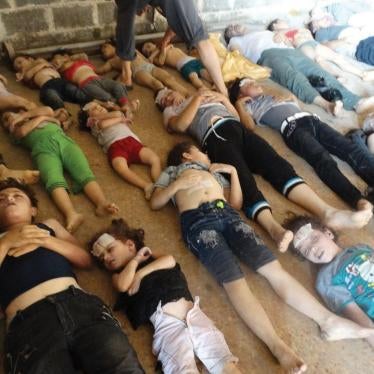(New York) – Mounting evidence shows that Syria’s air force is continuing to drop cluster bombs on towns across five governorates despite the Syrian army’s denial that it is using them, Human Rights Watch said today. Data compiled by Human Rights Watch shows an important increase in the use of cluster bombs in the past two weeks. The cluster bomb strikes are part of an intensifying air campaign by government forces on rebel-held areas that has included dropping high explosive, fragmentation, and even improvised “barrel” bombs into populated areas.
Following an October 14, 2012 report by Human Rights Watch on Syria’s use of cluster bombs, Syria’s army issued a statement denying it was using cluster bombs and saying it did not possess such weapons. Since then, Human Rights Watch has gathered new evidence of ongoing cluster bomb attacks by Syria’s air force and has confirmed them through interviews with victims, other residents and activists who filmed the cluster munitions, as well as analysis of 64 videos and also photos showing weapon remnants of 10 new cluster bomb strikes in or near the towns of Salkeen and Kfar Takharim in the Northern governorate of Idlib; Eastern al-Buwayda, Talbiseh, Rastan, and Qusayr in Homs governorate; al-Bab in Aleppo governorate; al-Duwair and al-Salheya in Deir al-Zor governorate; and Eastern Ghouta, near Damascus.
“Syria’s denial is meaningless as evidence mounts that cluster bombs are raining down on towns and villages,” said Steve Goose, arms director at Human Rights Watch. “Syria’s air force is imposing a reign of terror on civilians in rebel-held areas across the country with cluster bombs and other explosive weapons dropped from aircraft.”
Human Rights Watch has received information about more than 35 cluster bomb strike sites. The locations illustrate the broad scope of the use of cluster bombs. Videos and photos of cluster bomb remnants indicate that the Syrian air force has used at least 46 cluster bombs. Human Rights Watch has identified at least 136 unexploded bomblets from the attacks, all of which pose grave dangers to civilians. These are the tallies of strikes, bombs used, and explosive duds that can be determined from available sources, but are probably only a partial indication of the actual totals.
Human Rights Watch spoke to two cluster bomb victims in the town of Eastern al-Buwayda, as well as with residents in the towns of Rastan, Talbiseh, al-Bab, and Qusayr, who witnessed cluster bomb air strikes or filmed the aftermath and directly provided the footage or photos to Human Rights Watch.
The 64 videos Human Rights Watch reviewed were posted on YouTube in October showing the remnants of new cluster bomb attacks in Syria. In each video, Human Rights Watch experts identified cluster bombs containing explosive bomblets (also called submunitions) that apparently had been dropped by aircraft, including helicopters. Two types of RBK cluster bombs have been identified, one containing 150 AO-1SCh antipersonnel fragmentation bomblets and one containing 30 PTAB-2.5M anti-armor bomblets.
In most of the reviewed videos, the visible physical damage to the bombs and the submunitions show them to have been air-delivered, Human Rights Watch said. The cluster bombs show the wearing away of the paint of the suspension lugs that attach the bomb to the rack of the aircraft, as well as the extension of the ejection rod that breaks apart from the bomb after it is dropped. The physical damage to the stabilization fins on both types of cluster submunitions found in the videos indicates the aerodynamic force exerted on them and the deformation that occurred when they hit the ground. In many of the videos, the force of bombs and submunitions hitting the ground has caused them to be solidly lodged in the earth.
To ensure that the videos publicly posted show unique incidents, Human Rights Watch analyzed the types of submunitions deployed, the factory data and production data on the individual bombs and submunitions, the characteristics of the locations where the strikes took place, and the particular damage to the individual bombs and submunitions found. In a number of incidents, phone interviews with witnesses and victims provided additional confirmation of the strikes. Using these points of analysis, a database of unique strike incidents was built, showing the dramatic rise in the use of cluster munitions by the Syrian forces over the past two weeks.
A review of the markings on the bombs and the submunitions contained inside them, as well as a comparison with the Soviet manuals for the weapons, show that they were manufactured in the 1970s and early 1980s at Soviet state munitions factories. The most numerous submunitions identified are AO-1SCh antipersonnel fragmentation bomblets, and all appear to have been manufactured at a Soviet factory corresponding to the marking code of 55.
On October 15, the Russian foreign minister, Sergey Lavrov, denied the use of “Russian-made” cluster bombs in Syria. He said there was “no confirmation” of use and said it is very “difficult” to establish where the cluster munitions came from.
While it is not publicly known how or when Syria acquired its arsenal, RBK cluster bombs were produced and exported by the former Soviet Union in significant quantities. Authoritative publishers of specialist military hardware handbooks like IHS Jane’s, as well as materials published by the Russian military-industrial complex, state that RBK series cluster bombs were marketed by the Bazalt State Research and Production Enterprise in Moscow. No country other than the Soviet Union is known to have produced the RBK-250 series cluster bombs, or AO-1SCh and PTAB-2.5M bomblets.
“While Foreign Minister Lavrov may justify his denial as applying narrowly to modern ‘Russian-made’ cluster bombs, all the evidence so far shows that the weapons being dropped by Syrian government helicopters and jet aircraft originated in the Soviet Union,” Goose said. “Russia should be expressing concern at the use of cluster munitions in Syria and not questioning the compelling evidence that Soviet-made cluster munitions are being used.”
In recent days several governments have condemned Syrian use of cluster bombs, including Austria, Belgium, Denmark, France, Germany, Norway, and Qatar.
“All countries that care about protecting civilians from the harmful effects of cluster munitions and other explosive weapons should speak out and demand an end to the air campaign,” Goose said.
For more details on some of the cluster bomb attacks, please see below.
Attacks on Eastern al-Buwayda and Other Villages near Qusayr
Cluster bomb attacks on the village of Eastern al-Buwayda, near Qusayr, have wounded at least four people, according to multiple local residents, including two of those wounded. Hamza, a local resident and activist, told Human Rights Watch that the first cluster bomb attack on this village occurred on October 9, when a helicopter dropped a cluster bomb near the house of Umm Nazir, a 60-year-old woman. Hamza sent Human Rights Watch footage of remnants of the bomb that he says was used on October 9. Human Rights Watch experts identified the remnants as those of a cluster bomb. A doctor had to amputate both of Umm Nazir’s legs in a field hospital. A neighbor described the attack.
It was around 3 p.m. when I heard one small explosion and then a series of explosions, but not very loud. The house didn’t shake when the bomb hit the street. Buildings around where the cluster bomb was dropped…only had small holes but not very deep. The cluster bomb hit a street with 10 buildings. The buildings are inhabited but most residents were not hurt. One woman called Umm Nazir was injured. Her house was 20 meters away from where we found the tail of the bomb. Her 30-year-old son was with her in the same house and was injured. He had injuries all over his body from shrapnel but they were not deep or severe.
Hamza sent Human Rights Watch two videos showing an elderly woman whom he identified as Umm Nazir, lying in a makeshift hospital with both her legs amputated.
Residents said that a helicopter dropped another cluster bomb on Eastern al-Buwayda at approximately 5:30 p.m. on October 16, but there were no casualties. Human Rights Watch reviewed footage sent by another local activist who filmed the remnants of the bomb that the residents said fell on October 16, and confirmed that it was a cluster munition. A local activist who filmed the site of the attack said that it was about 300 meters from the October 9 strike:
When I went to the area where the bomb was dropped I saw the walls of a building covered with small holes, around 0.5 centimeters in diameter. On the street I saw several small holes as well, the same size as the ones in the building. They spread throughout the neighborhood, maybe 200 meters long. The tail of the bomb fell on the wall of a building, but there was nobody inside. It destroyed the wall. The second half was found 50 meters away and not near a building. It was in the street.
A local activist told Human Rights Watch that Free Syrian Army soldiers found 15 unexploded bomblets that day. They disarmed the bomblets by removing the fuse with a hammer, the activist said, an extremely dangerous action. The witness said that a separate cluster bomb hit the neighboring village of Abel, but no footage of the remnants is available.
According to local residents, the next day, on October 17, at around 4:30 p.m. to 5 p.m., a helicopter dropped another cluster munition on Eastern al-Buwayda, wounding three young men. Human Rights Watch interviewed two men who said they had been wounded by the cluster munition attack: Hakim (last name withheld), 27, and Ayham (last name withheld), a 22-year-old army defector. Hakim said:
We were standing at the door of a house watching the helicopter hovering over us. Suddenly, I saw something drop from the helicopter. We did not know what to do so we started running toward the olive trees. Suddenly, I just heard a quick succession of explosions and found myself wounded by shrapnel in my back, my arms, my side. I was taken to the field hospital but my injuries were not very severe.
Ayham told Human Rights Watch that he was more seriously injured as he was behind Hakim: “It was as if someone was firing a machine gun. I was injured in my back.” Hakim and Ayham shared with Human Rights Watch a video showing them wounded and being treated at the field hospital for wounds consistent with their testimony. According to a local activist, Free Syrian Army soldiers found four unexploded bomblets from the October 17 strike and disarmed them, again a very dangerous activity.
Abu Habib, an activist from Qusayr, told Human Rights Watch that a helicopter dropped a cluster bomb on his town at 11 a.m. on October 18:
The media center [where I was] is 300 meters away from where the helicopter dropped the bomb. My friends told me they found bomblets so I joined them. The bomblets we found were near Al Rahman mosque. The bomblets extended around 100 meters along the neighborhood. I saw 15 bomblets that had penetrated the ground. Residents out of curiosity were trying to pull them from the ground. I told them that they are dangerous but they wouldn’t listen. The bomblets were around 20cm long and 2cm diameter.
FSA then came and dismantled them after they removed them and took them away from the people. There were no injuries because before the helicopter dropped the bomb there was another helicopter shelling so people were in hiding… It is hard to tell if there was any destruction in the building because they are already destroyed and damaged from the tank shelling and helicopter rockets.
Abu Habib sent Human Rights Watch a photo showing 10 unexploded bomblets. Human Rights Watch has not been able to independently verify Abu Habib’s account.
Attacks on al-Bab
Human Rights Watch also received information that on October 15, a fighter jet dropped a cluster bomb on the city of al-Bab at around 5 a.m. A local activist told Human Rights Watch that the bomb fell near a building that had previously been used by the Free Syrian Army but that the fighters had left it two months ago. No one was injured in the attack, the activist said. He sent Human Rights Watch photos of the bomb and said that unexploded bomblets were disarmed by a special committee formed by the civilian council of the city.
